 For our penultimate day in Sicily our plans called for a drive toward Palermo to the town of Monreale, a community that could be described as a Palermo suburb perched on a mountain. The purpose of our visit was to meet with Maria Grazia, the owner of Elisa Messina Ceramics, a Sicilian ceramics studio that we were introduced to by the Italian Trade Commission (ICE) back in December. The day would also give us the opportunity to spend a little time in and around Palermo.
For our penultimate day in Sicily our plans called for a drive toward Palermo to the town of Monreale, a community that could be described as a Palermo suburb perched on a mountain. The purpose of our visit was to meet with Maria Grazia, the owner of Elisa Messina Ceramics, a Sicilian ceramics studio that we were introduced to by the Italian Trade Commission (ICE) back in December. The day would also give us the opportunity to spend a little time in and around Palermo.
We departed the villa beach house late in the morning, running behind schedule, naturally, for our appointment. When we called Maria Grazia to tell her we were running late, she suggested that we take a shorter route than the all highway track that we had planned. She informed us that the shorter, preferred route was a nice mountain road. She wasn’t kidding. At least about the mountain part. When we exited the highway at Partinico, the road narrowed a bit, but it wasn’t for another fifteen minutes or so that the climb commenced, taking us along the steep sides of mountains that were no more than huge boulders with roads carved through them. Below, the valley was largely uninhabited with a few small villages dotting the hillsides here and there. Along the way I am quite sure we saw a few airplanes flying below us.
As we emerged from the mountains to the peak that Monreale occupies, Palermo stretched out below us to the sea. It is an immense, sprawling city. Full of traffic. But for the next several hours at least we would be enjoying the much quainter town of Monreale.
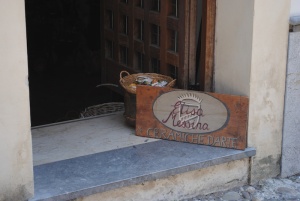 We parked in the municipal lot and walked up some stairs to the level of the main town and proceeded to look for Elisa Messina, one of the premier ceramics studios in Palermo and all of Sicily. Just a hundred meters up the main pedestrian walkway we found it, an unimposing looking shop with a high door and a couple of large display windows and a tiny sign announcing its presence. We entered and were greeted by Maria Grazia who obviously recognized us as foreigners, Americans and Bill and Suzy. She greeted us warmly and immediately began to talk about her studio, her designs and artistic inspirations and, most of all, her mother. It was obvious that her mother, Elisa Messina, had greatly influenced Maria Grazia’s life and work. This studio and this store were testimony to her devotion to keeping alive the family name and reputation.
We parked in the municipal lot and walked up some stairs to the level of the main town and proceeded to look for Elisa Messina, one of the premier ceramics studios in Palermo and all of Sicily. Just a hundred meters up the main pedestrian walkway we found it, an unimposing looking shop with a high door and a couple of large display windows and a tiny sign announcing its presence. We entered and were greeted by Maria Grazia who obviously recognized us as foreigners, Americans and Bill and Suzy. She greeted us warmly and immediately began to talk about her studio, her designs and artistic inspirations and, most of all, her mother. It was obvious that her mother, Elisa Messina, had greatly influenced Maria Grazia’s life and work. This studio and this store were testimony to her devotion to keeping alive the family name and reputation.
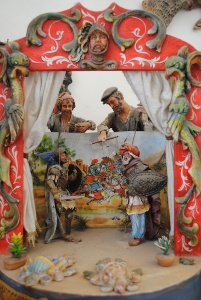 For ceramics vendors such as we who are more familiar with the Umbrian and northern Italian style, the ceramics of Sicily, as was obvious in Maria Grazia’s shop, are a completely different breed. In place of the stylized, more formal patterns of the north, Sicilian ceramic art is much freer, less precise and, at least compared to some northern art perhaps more artisitic, if by artistic you mean able to reflect the artist’s particular inner light. The works in Elisa Messina were jammed everywhere – on tables, in shelves and hanging on the walls – and within a few minutes it was clear which works were from Maria Grazia and her studio and which were produced elsewhere for resale by Elisa Messina. The originals, regardless of the type of piece – plate, figurine, wall hanging – stood out from the rest as though a tiny spotlight illuminated them. Each of the Messina pieces seemed alive, fresh and original, rather than the competence but plasticity that marked the other pieces.
For ceramics vendors such as we who are more familiar with the Umbrian and northern Italian style, the ceramics of Sicily, as was obvious in Maria Grazia’s shop, are a completely different breed. In place of the stylized, more formal patterns of the north, Sicilian ceramic art is much freer, less precise and, at least compared to some northern art perhaps more artisitic, if by artistic you mean able to reflect the artist’s particular inner light. The works in Elisa Messina were jammed everywhere – on tables, in shelves and hanging on the walls – and within a few minutes it was clear which works were from Maria Grazia and her studio and which were produced elsewhere for resale by Elisa Messina. The originals, regardless of the type of piece – plate, figurine, wall hanging – stood out from the rest as though a tiny spotlight illuminated them. Each of the Messina pieces seemed alive, fresh and original, rather than the competence but plasticity that marked the other pieces.
And what fun the pieces are. Fully half of Maria Grazia’s works are figurines or other 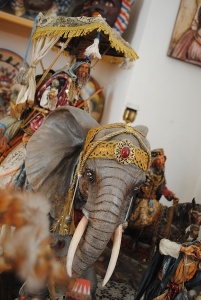 likenesses of people – characters from The Leopard, mythological lovers, magi and musicians. This added to the vibrancy and appeal of the pieces and the shop as a destination.
likenesses of people – characters from The Leopard, mythological lovers, magi and musicians. This added to the vibrancy and appeal of the pieces and the shop as a destination.
We heard much from Maria Grazia about the history of her family, the notoriety and devotion that it attracted from the people of Palermo, the famous visitors/customers they had attracted over the years. It was clear that Elisa Messina is something out of the ordinary, special and worth supporting. Maria Grazia admitted as much when she recounted how she often loses money going to trade shows but that “it is important that people see this, touch this and understand what it is and why it is.” Making a living at selling ceramics is an imperative. But giving the world these ceramics and giving people the opportunity to appreciate them is what truly drives her.
* * *
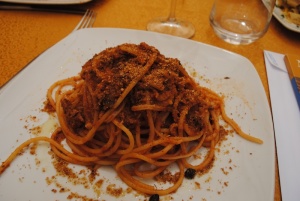 We finished our business with Maria Grazia, ordering a number of pieces for Bella Italia and then said our goodbyes. We met up with our friends and headed to a small trattoria for a light lunch on a street tucked away a few blocks from Monreale’s famous cathedral. Although the service was a bit rushed and the food not as good as our previous meals on Sicily, it was striking how interesting and alive even mediocre cooking is on this island. Pine nuts, walnuts, pistachios, raisins, cinnamon all give
We finished our business with Maria Grazia, ordering a number of pieces for Bella Italia and then said our goodbyes. We met up with our friends and headed to a small trattoria for a light lunch on a street tucked away a few blocks from Monreale’s famous cathedral. Although the service was a bit rushed and the food not as good as our previous meals on Sicily, it was striking how interesting and alive even mediocre cooking is on this island. Pine nuts, walnuts, pistachios, raisins, cinnamon all give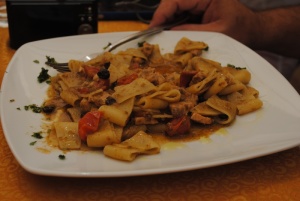 Sicilian cuisine an exotic yet faintly recognizable allure. Eggplants, peppers, vinegar all combine to make a vibrant stew that tantalizes and enchants, a vibrancy and aliveness that we saw in Elisa Messina’s ceramics. The island of Sicily, conquered so many times, subjugated by dozens of foreign rulers, dirt poor, hot and cut off from the rest of the world has never lost its zest for life. You see it in their food, in their art, in their traffic and in the way they park their cars. It is a cacophony of sights, sounds and smells that says “we have all that we need. It’s good to be alive.”
Sicilian cuisine an exotic yet faintly recognizable allure. Eggplants, peppers, vinegar all combine to make a vibrant stew that tantalizes and enchants, a vibrancy and aliveness that we saw in Elisa Messina’s ceramics. The island of Sicily, conquered so many times, subjugated by dozens of foreign rulers, dirt poor, hot and cut off from the rest of the world has never lost its zest for life. You see it in their food, in their art, in their traffic and in the way they park their cars. It is a cacophony of sights, sounds and smells that says “we have all that we need. It’s good to be alive.”
* * *
After lunch we made a brief stop at Monreale’s cathedral. I wish I could tell you a little bit about it, but I did not read up on it before going. I didn’t need to. Earlier in the week I saw photos of the incredible mosaics that cover every surface in this immense cathedral. I didn’t need to know any more. I just needed to go see for myself.
I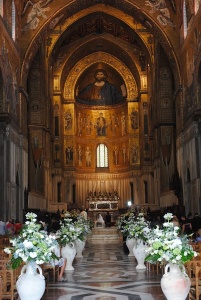 had intended to look over a guidebook when we got to the cathedral, to learn the meaning of the mosaics, the orgins of the architecture. And when we entered, much of it was clear. Along the main aisle there were enormous mosaic panels depicting old testament stories, of particular interest the life of Noah. And above the main altar was an enormous mosaic depiction of Christ, the scale and beauty of which I had not seen since our visit to Istanbul. It was truly awe inspiring.
had intended to look over a guidebook when we got to the cathedral, to learn the meaning of the mosaics, the orgins of the architecture. And when we entered, much of it was clear. Along the main aisle there were enormous mosaic panels depicting old testament stories, of particular interest the life of Noah. And above the main altar was an enormous mosaic depiction of Christ, the scale and beauty of which I had not seen since our visit to Istanbul. It was truly awe inspiring.
But our studies were cut short because a wedding was taking place in the cathedral. When we arrived, several dozen guests were waiting for the entry of the bride and groom while tourists shuffled up and down the aisle, looking at the mosaics and snapping pitures of the wedding party. A few minutes later the bride and groom arrived and as they entered the church the priest admonished the tourists not to interfere in the ceremony. It was truly surreal to have a wedding taking place among such hubbub. But such is Sicily.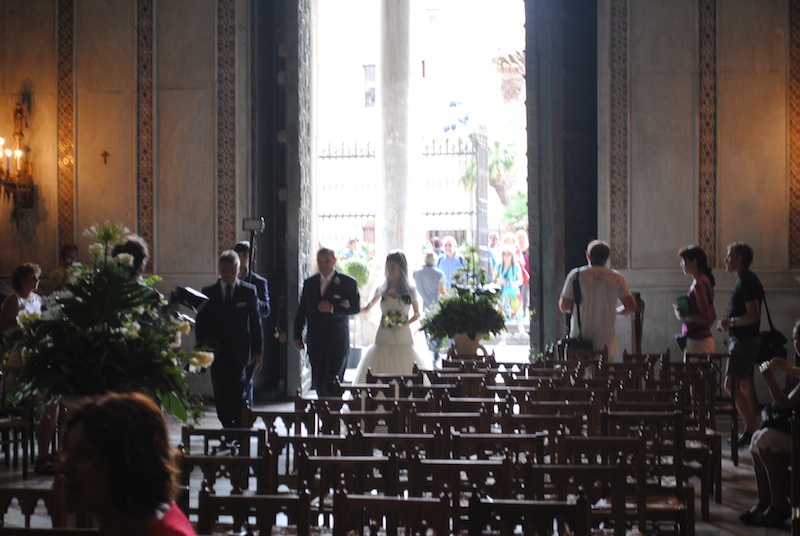
* * *
 Before leaving the cathedral and Monreale we paid a two euro tribute to the church and were allowed to scale a tower that led to a walkway along the cathedral’s roof. From there one could survey from above the entire enormous church complex, particularly its expansive cloister. A further passageway, punctuated by small arches that were boarded up but sporting a few knot holes through which you could see the cathedral and the wedding party below led to the rear of the cathedral, on the roof just above the enormous mosaic of Christ. From there a stairway led to a balcony from which we were treated to a breathtaking view of Palermo below. Breathtaking because of the expansiveness of Palermo and the beauty of the manmade town as it stretches to the sea, enclosed by mountains, but breathtaking too because even without claustrophobia or agoraphobia, the height, the absolute nakenedness and the insignificance of being a tiny speck in this vast expanse can’t but take your breath away. That, too, is Sicily.
Before leaving the cathedral and Monreale we paid a two euro tribute to the church and were allowed to scale a tower that led to a walkway along the cathedral’s roof. From there one could survey from above the entire enormous church complex, particularly its expansive cloister. A further passageway, punctuated by small arches that were boarded up but sporting a few knot holes through which you could see the cathedral and the wedding party below led to the rear of the cathedral, on the roof just above the enormous mosaic of Christ. From there a stairway led to a balcony from which we were treated to a breathtaking view of Palermo below. Breathtaking because of the expansiveness of Palermo and the beauty of the manmade town as it stretches to the sea, enclosed by mountains, but breathtaking too because even without claustrophobia or agoraphobia, the height, the absolute nakenedness and the insignificance of being a tiny speck in this vast expanse can’t but take your breath away. That, too, is Sicily.
* * *
After marveling at Palermo from above, we left Monreale. Opting the highway route over a return trip on the mountain road, we fought our way through Palermo traffic before reaching open stretches of highway leading back to the beaches of the southwestern shore of this triangle of an island. Our day had taken us to the city and although we only saw it for a brief moment, it felt good to be back in the country on the beach and back at home.
Ci vediamo!
Bill and Suzy

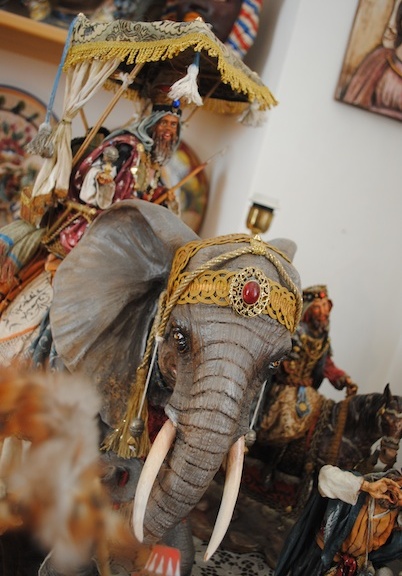
Hi Bill and Suzy!
I’m a very good friend of Jeanne Pettenati and have been in your beautiful store a number of times. I live in Texas but am from the DC area. I teach Italian here at Texas Christian University.
I’m currently writing a book on the Italian language (specifically regarding cognates/twin words, essential vocabulary and tips, strategies for fluency, etc.) In the last section there is a Resources Section, and therein I have listed blogsites regarding Italian Language and Culture. I’d like to include your blog if it would be OK with you.
Looking forward to returning to your shop!
carissimi saluti,
Susan
Thanks for the kind words, Susan. You may certainly include us in your book. And our speaking fees are quite reasonable, too, I might add!